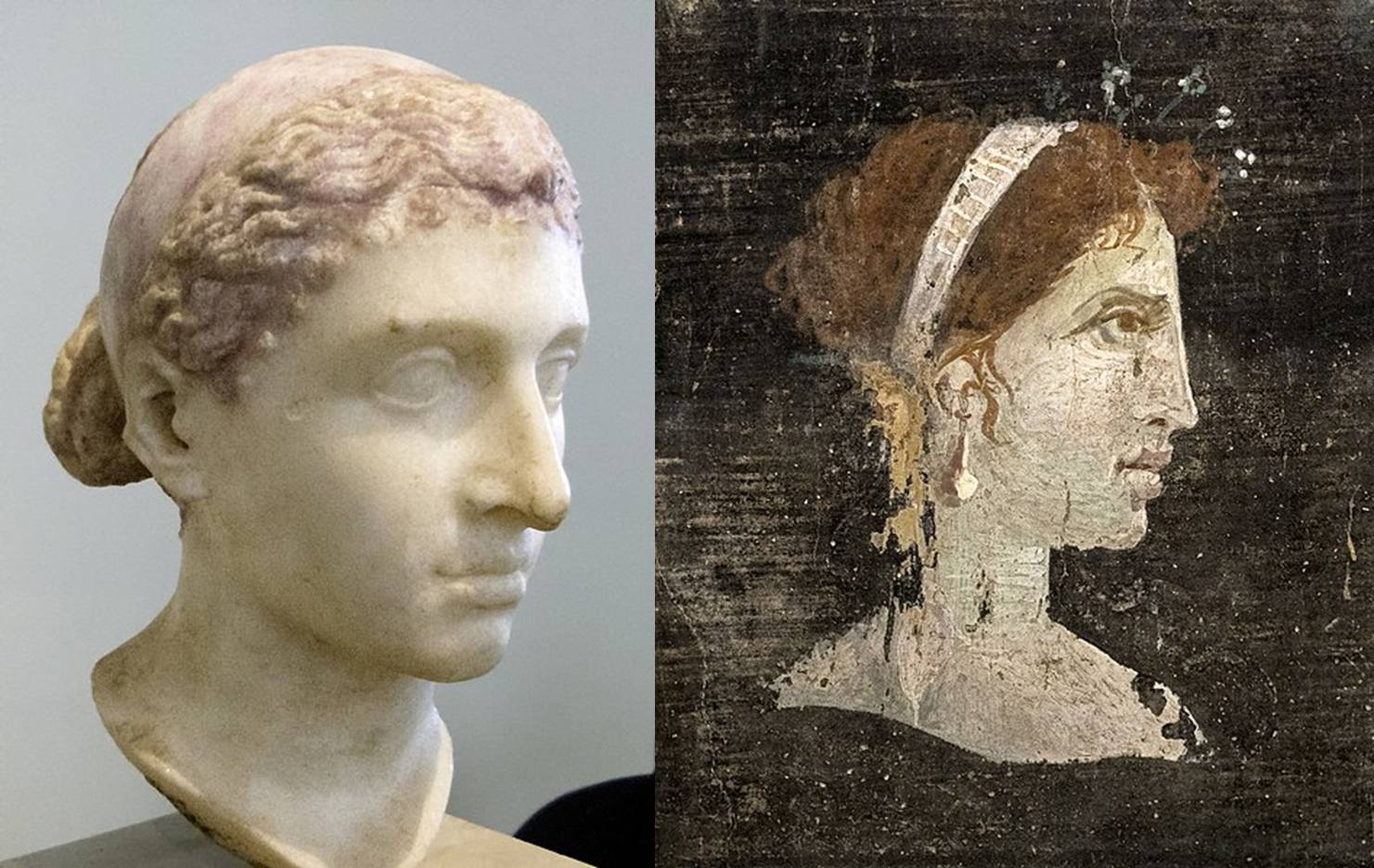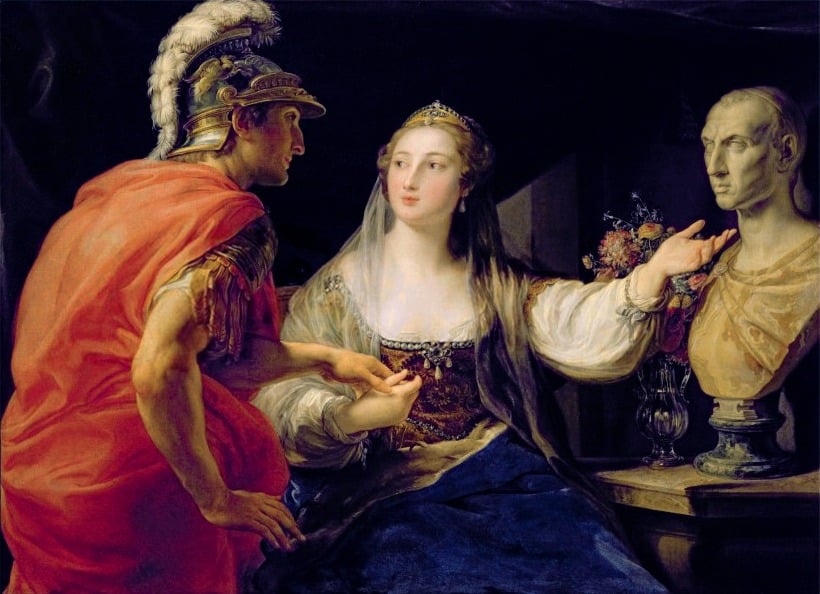
Cleopatra VII Philopator is one of the most famous figures of antiquity, having ruled over ancient Egypt between 51 and 30 BC. A heroine to some and a villainess to others, her fate was intimately tied to the fortunes of the Ptolemaic Kingdom, of which she was the last ruler.
Today, Cleopatra is most famed for her various love affairs, which have been the subject of films, television series, novels, and stage plays. Cleopatra’s affairs with the prominent Roman generals and statesmen Julius Caesar and Mark Anthony have a place in the common consciousness that few other historical romantic entanglements have ever achieved.
However, these affairs were not driven exclusively – or perhaps even primarily – by feelings of passion, love, or romantic sentiment; they were instead examples of cold hard realpolitik. To secure the future of her kingdom, her dynasty, and her own political position, Cleopatra needed powerful allies, and the leading men of the Mediterranean’s preeminent great power were the ideal candidates.
Cleopatra VII and her lovers in fiction and reality
Cleopatra and her lovers have been a popular topic over the centuries for various works of historical fiction, greatly coloring the popular perception of her character.
Our modern conception of this enigmatic queen has arguably been shaped the most by The Tragedy of Antony and Cleopatra, written by the English playwright William Shakespeare. The play focuses on the romance between the eponymous characters and their tragic demise following the ill-fated Battle of Actium.
In almost equal stature in the popular imagination of Cleopatra to Shakespeare’s play is the 1963 movie Cleopatra, starring Elizabeth Taylor as the eponymous Ptolemaic ruler and Richard Burton as her lover, Mark Anthony.
In terms of the historical record, the two most important names in the list of Cleopatra’s lovers are undoubtedly Julius Caesar and Mark Anthony. Although historians have proposed other potential romances, these two names are the most consequential, since both men commanded immense political and military power in ancient Rome.

Julius Caesar
The Roman general and statesman Julius Caesar arrived in Egypt in 48 BC. At the time, the Roman Republic was embroiled in a brutal civil war and Caesar was in pursuit of his bitter rival, Pompey.
When Caesar arrived in Egypt, Ptolemy XIII – the brother of Cleopatra VII and king of Egypt – presented Caesar with the severed head of Pompey. Although Caesar and Pompey were rivals, it is said that he was saddened to see that his adversary had met this end.
Ptolemy XIII successfully allied himself with Caesar who decided to stay in Egypt longer than expected. However, Ptolemaic Egypt suffered from divisions of its own. According to the will of Ptolemy XII, his children, Ptolemy XIII and Cleopatra VII would rule together as co-monarchs over Egypt, but this arrangement had fallen apart and Ptolemy had exiled his sister Cleopatra.
Caesar sought to mediate the dispute. Much to Ptolemy’s chagrin, Caesar received Cleopatra in Alexandria and eventually decided to resolve the dispute in her favor. Ultimately, this resulted in the Battle of the Nile in 47 BC which pitted the forces of Caesar and Cleopatra against Ptolemy. Ptolemy lost and was forced to flee the city. He later drowned trying to cross the Nile.
During this time. Caesar and Cleopatra developed a relationship that was both political and romantic. This relationship was mutually beneficial. Cleopatra aimed to safeguard Egypt’s autonomy, while Caesar sought to expand his influence in the eastern Mediterranean. Their alliance allowed them to consolidate power and establish a formidable force against their opponents.
On June 23, 47 BC, Cleopatra gave birth to Caesarion, her child with Caesar. He was the only known biological son of Caesar and would go on to become the last sovereign member of the Ptolemaic dynasty.
In 46 BC, Cleopatra visited Rome with her other younger brother and now-husband Ptolemy XIV. Ptolemy XIV was elevated to co-ruler with his sister for the sake of political stability. However, Ptolemy XIV, who was only a young boy, had no real political power and Cleopatra maintained her relationship with Caesar.
During her long stay in Rome, Cleopatra stayed at Caesar’s villa, where he bestowed upon her and Ptolemy XIV the title of “friend and ally of the Roman people”. This essentially meant that Egypt was a client state and ally of Rome.
On March 15, 44 BC, Caesar was assassinated by a group of Roman senators. Cleopatra hung on in Rome until about mid-April. She probably hoped that her son Caesarion would be named as Caesar’s heir, but his grandnephew Octavian received this honor instead.

Mark Anthony
Further civil strife and war followed the assassination of Caesar, but ultimately the men who avenged his murder emerged as the most powerful men in Rome. The Roman Republic’s provinces were divided between the triumvirate of Octavian, Mark Anthony, and Lepidus.
Under Octavian’s control were most of the western provinces; to Lepidus went Spain, although he later gave it to Octavian in exchange for parts of Africa and was then sidelined in any case; and to Anthony went the wealthy eastern provinces and the Hellenistic world.
It was at this critical juncture in Roman and Egyptian history that Cleopatra would again find herself embroiled in a love affair with one of Rome’s leading men.
Anthony was ambitious to enhance his reputation by launching a campaign against the Parthians, a formidable foe that had previously beaten the Romans at the Battle of Carrhae in 53 BC. There was also a growing rivalry between the triumvirs, particularly between Octavian and Anthony. To achieve his goals, Anthony needed funds, and it just so happened that Cleopatra was tremendously wealthy.
In 41 BC, Anthony requested the presence of Cleopatra at Tarsus, a city in Anatolia. To heighten Anthony’s anticipation of the visit, Cleopatra delayed and demurred. When she did finally decide to make an appearance, she did so with a grand and intoxicating entrance.
Cleopatra made her entrance into Tarsus by sailing up the Cydnus River on a grand vessel adorned with a golden prow, sails in rich purple hues, and oars made of silver. Accompanied by musicians playing music, Cleopatra reclined under a canopy intricately embroidered with gold, resembling Aphrodite, the Greek goddess of love. Young individuals dressed as Eros fanned her, and girls dressed as sea nymphs attended to her needs, while servants released fragrant perfumes into the air, captivating the onlookers who lined the riverbanks.
This grand entrance was followed up with an equally ostentatious banquet, in which, according to Athenaeus – who based his own account on the words of Socrates of Rhodes – Cleopatra adorned the dining area with gold, gems, and richly decorated purple carpets.

The Greek historian Plutarch noted that Cleopatra believed that Anthony would prove easier to seduce than Caesar. Whatever the case, the pair did indeed form both a romantic relationship and an alliance.
Anthony and Cleopatra spent the winter of 41 to 40 BC in Alexandria, where they enjoyed the city’s unique mixture of ancient Greek and Egyptian culture. They were reputed to have formed a drinking club called “The Inimitable Livers,” in honor of Dionysus.
Cleopatra gave birth to twins, Alexander Helios, which means sun, and Cleopatra Selene, which means moon, shortly after Anthony returned to Rome in 40 BC.
The alliance between Anthony and Cleopatra had proven mutually beneficial, but ultimately, the lovers would face defeat and death together. Relations between the Roman triumvirs broke down and Octavian and Anthony plunged the Roman world into civil war once more. In 31 BC, the combined forces of Anthony and Cleopatra were defeated at the sea battle of Acticum, effectively sealing their fates.
In 30 BC, Octavian’s forces landed in Egypt. Anthony was able to win a small victory on land at first, but his fleet then surrendered to Octavian followed by his cavalry. Anthony’s military position was now truly hopeless.
After his forces were defeated, and believing falsely that Cleopatra had killed herself, Anthony attempted suicide by falling on his own sword. However, he did not succeed in taking his own life immediately. When news reached Cleopatra that Anthony was still alive, he was brought to her monument. According to Plutarch, Anthony died there from his self-inflicted wounds on August 1, 30 BC.
Devastated by Anthony’s death and faced with the prospect of being paraded as a captive in Rome, Cleopatra resolved to take her own life. According to historical accounts, she arranged for poisonous asps (Egyptian cobras) to be smuggled into her chambers. Cleopatra allowed one of the venomous snakes to bite her, causing her death. She died on August 12, 30 BC.
After her death, Egypt was annexed by Octavian, who became the first Roman emperor. Cleopatra Selene was the only child of Cleopatra who survived and after a period spent as a political prisoner in Rome, she would go on to become the queen of Mauretania.

See all the latest news from Greece and the world at Greekreporter.com. Contact our newsroom to report an update or send your story, photos and videos. Follow GR on Google News and subscribe here to our daily email!



